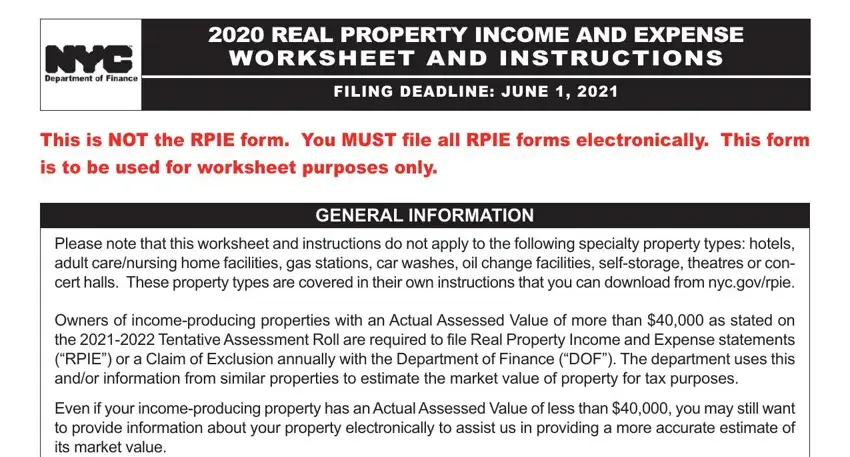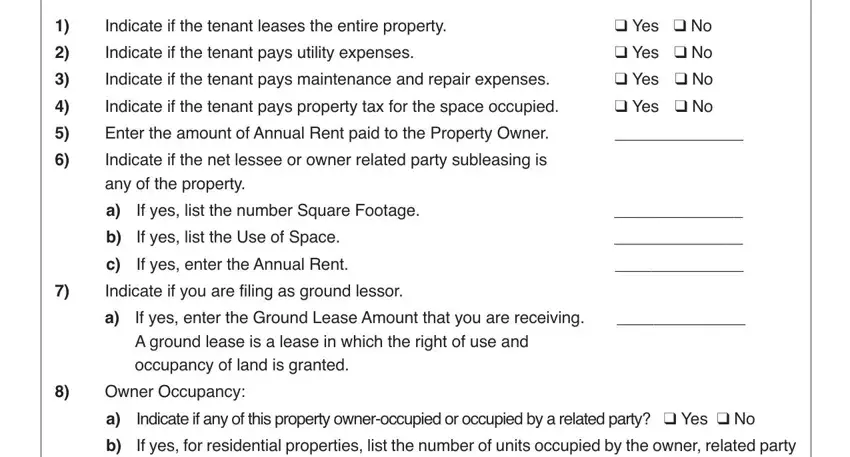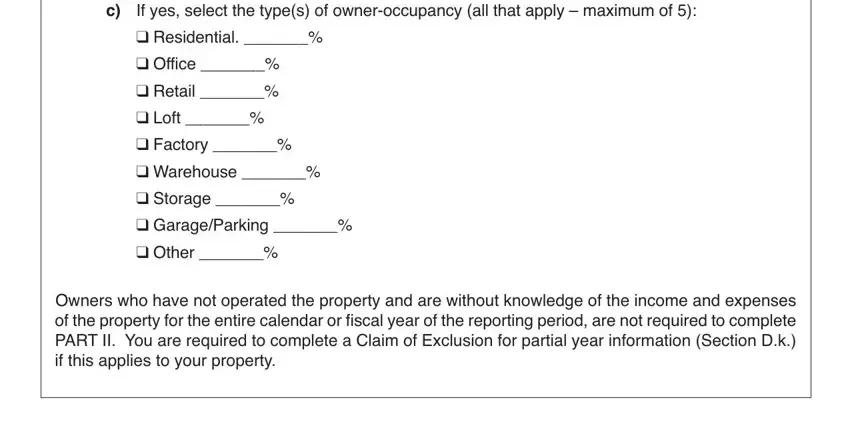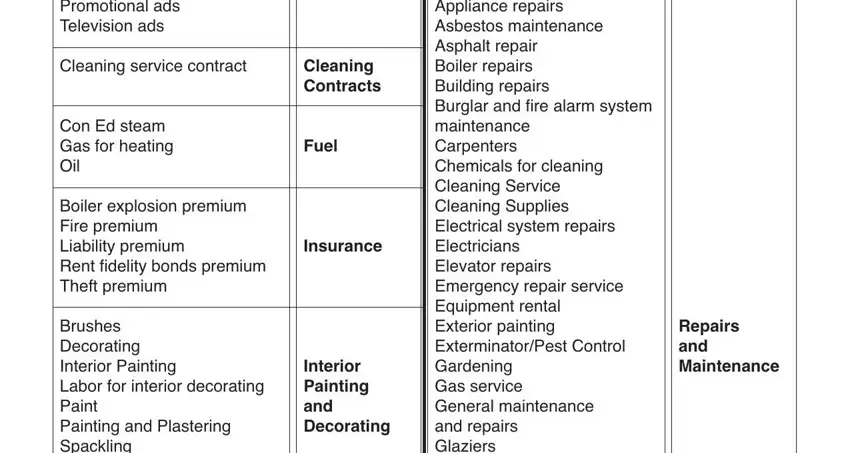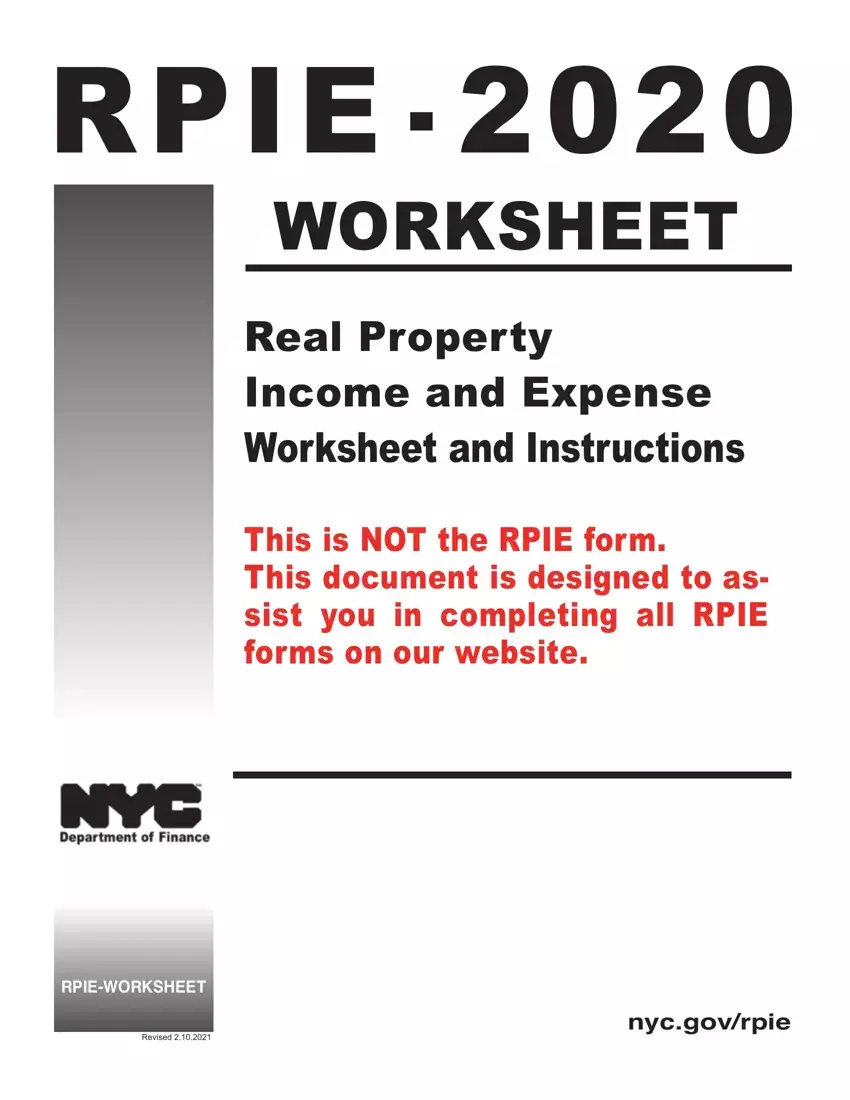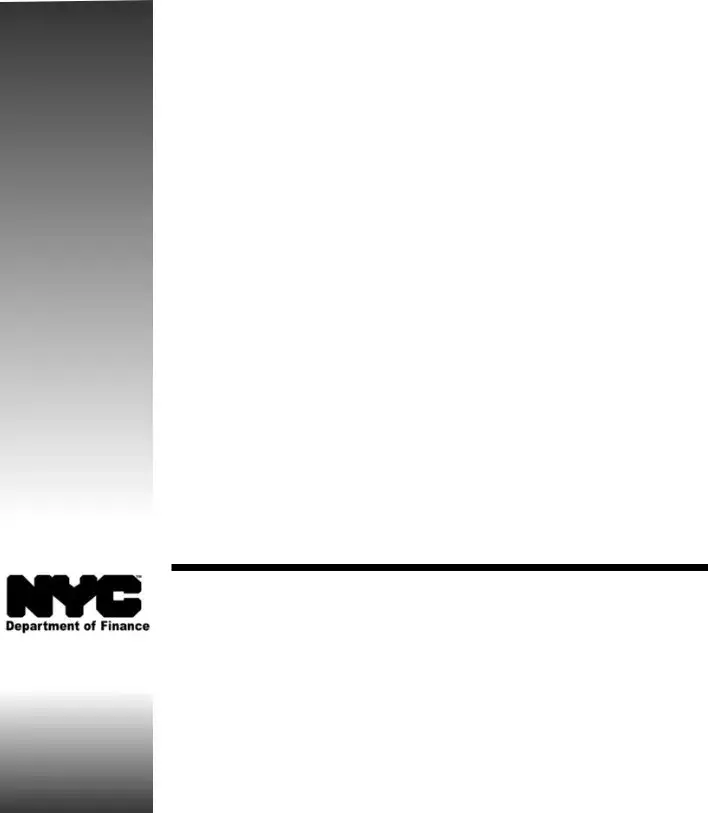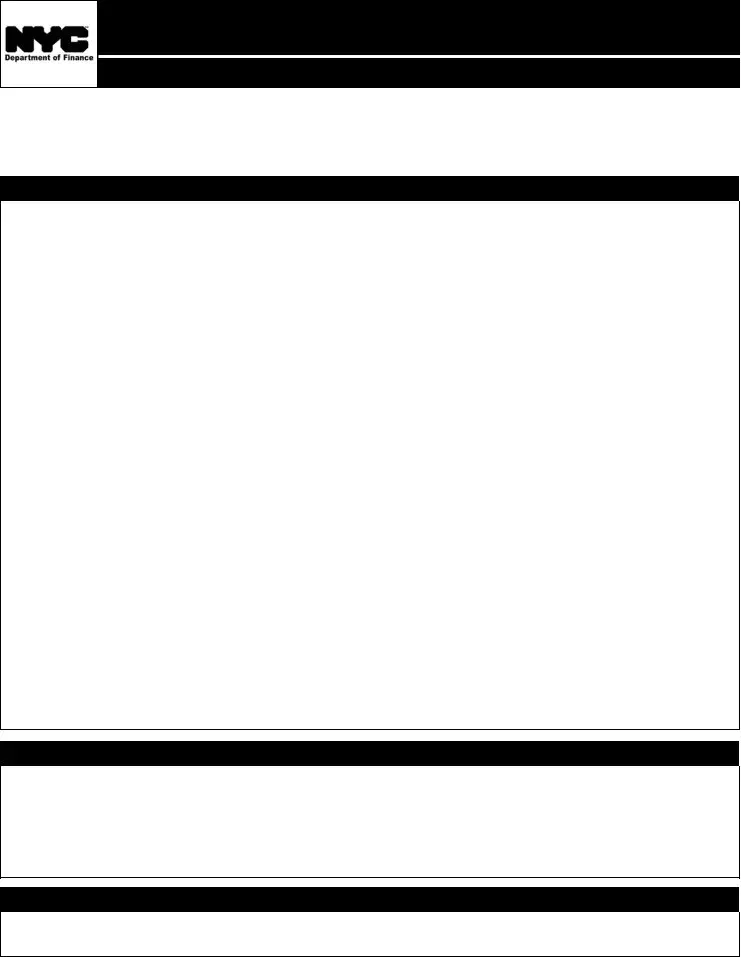WORKSHEET
Real Property
Income and Expense
Worksheet and Instructions
This is NOT the RPIE form.
This document is designed to as- sist you in completing all RPIE forms on our website.
RPIE-WORKSHEET
nyc.gov/rpie
2020 REAL PROPERTY INCOME AND EXPENSE WORKSHEET AND INSTRUCTIONS
FILING DEADLINE: JUNE 1, 2021
This is NOT the RPIE form. You MUST file all RPIE forms electronically. This form
is to be used for worksheet purposes only.
GENERAL INFORMATION
Please note that this worksheet and instructions do not apply to the following specialty property types: hotels, adult care/nursing home facilities, gas stations, car washes, oil change facilities, self-storage, theatres or con- cert halls. These property types are covered in their own instructions that you can download from nyc.gov/rpie.
Owners of income-producing properties with an Actual Assessed Value of more than $40,000 as stated on the 2021-2022 Tentative Assessment Roll are required to file Real Property Income and Expense statements (“RPIE”) or a Claim of Exclusion annually with the Department of Finance (“DOF”). The department uses this and/or information from similar properties to estimate the market value of property for tax purposes.
Even if your income-producing property has an Actual Assessed Value of less than $40,000, you may still want to provide information about your property electronically to assist us in providing a more accurate estimate of its market value.
RPIE EXCLUSIONS
How do you file a Claim of Exclusion?
To file a Claim of Exclusion, you must complete Section D of the RPIE-2020 form. Owners of real prop- erty who are not required to file income and expense information must submit a Claim of Exclusion each year.
Please note: If you own the property but have no knowledge of the income and expenses for the entire calendar or fiscal year, you must file a Claim of Exclusion.
Who does not have to file an RPIE or Claim of Exclusion? Owners with:
●Properties that have an Actual Assessed Value of $40,000 or less.
●Residential properties containing 10 or fewer dwelling units.
●Tax class 1 or tax class 2 properties with six or fewer dwelling units and no more than one commercial unit.
●Special franchise properties.
IMPORTANT FILING INFORMATION
●Online Filing Requirement -- All filers are legally required to file electronically unless Finance grants a waiver. Filers who wish to request a waiver from the electronic filing should call 311 for an application or download the application from nyc.gov/rpie. The deadline for electronic waiver requests is May 3, 2021.
●Deadline -- The submission deadline for all RPIE filings is June 1, 2021.
CUSTOMER ASSISTANCE
Please call 311 or email Finance at rpie@finance.nyc.gov
Instructions for Worksheet RPIE-2020 |
Page 2 |
PART I: OWNER AND PROPERTY INFORMATION
Please check your mailing address for accuracy. Owners are responsible for maintaining a current mail- ing address with Finance at all times. You can see the mailing address on file by looking at your latest Notice of Property Value or Property Tax bill. Changes to your address can be made online at http://nyc.gov/changemailingaddress or by calling 311.
SECTION A – OWNER/FILER INFORMATION
1a. Enter name(s) of up to two owners of the property.
b./c. Enter each listed owner’s Employer Identification Number (EIN) or Social Security Number (SSN).
The Federal Privacy Act of 1974, as amended, requires the Department of Finance to inform you about whether compliance with the request is voluntary or mandatory, the legal authority to request the in- formation, and how the information will be used. Owners must provide their Social Security Number on this form under the authority of section 11-102.1 of the Administrative Code of the City of New York. Social Security Numbers are required to facilitate the processing of real property income and expense data for tax administration purposes. The Social Security Numbers may be further disclosed to other departments or agencies, or to persons employed by such departments or agencies, only for tax ad- ministration purposes, or as otherwise provided by law or judicial order.
2a. Enter the name of the person filing the RPIE. The filer may be an owner, owner representative, lessee or lessee representative who is authorized to provide this information and has knowledge of such information.
b./c. Enter the filer’s Employer Identification Number or Social Security Number.
d.Use the dropdown box to select the filer’s relationship to the property.
SECTION B - CONTACT INFORMATION
Provide contact information for the person who can respond to questions about this filing and receive the confirmation email once the RPIE is submitted. Additional email addresses for the confirmation email can be entered on the Certification page.
SECTION C – CONSOLIDATED LOTS
(To access, first check box in Section A for consolidated lots)
Consolidated lot filings apply to two or more properties that meet the following criteria:
●Operate as a single economic unit
●Be located in the same borough
●Share the same ownership
●Have the same Tax Class
●All must be hotels if one is a hotel
●Be located on contiguous lots*
* Contiguous lots are those that share either an edge or boundary, are neighboring, adjacent, or ad- joining. This definition can include nearby lots within the same tax block or those separated by roads or paths.
Instructions for Worksheet RPIE-2020 |
Page 3 |
|
|
Please note that consolidated lot filings are not available for the following specialty property types: adult care/nursing home facilities, gas stations, car washes, oil change facilities, self-storage, theatres or concert halls.
If your properties meet all the above criteria and you want to submit a consolidated filing, allocate the properties’ income and expense using either square footage or number of units. Select allocations by a percentage of income to each lot only if square feet or number of units is inappropriate for al- locating your properties’ income and expense.
SECTION D - RPIE EXCLUSIONS
If you are identified as a required RPIE-2020 filer, you will need to complete an income and expense form or complete a claim of exclusion in Section D. If your property is income-producing and eligible to claim an RPIE exclusion, please identify one of the exclusions listed in the section below.
Exclusions include:
a.Actual AV (Assessed Value) as shown on the Tentative Assessment Roll 2021-2022 is $40,000 or less.
b.The property is both exclusively residential and has 10 or fewer apartments, including both vacant and occupied units.
c.The property has both of the following: six or fewer residential units and no more than one com- mercial unit. Your property must be in Tax Class 1 or Tax Class 2 and the unit count must include all units whether vacant or occupied. For example, if your property has five residential and two commercial units, you must file an RPIE because you have two commercial units.
d.Residential cooperative apartment buildings with no more than 2,500 square feet of commercial space (not including garage space). To claim this exclusion you must still complete the RPIE-2020 (Parts I and IV). An RPIE is required for unsold sponsor-owned units if 10% or more of the units remain unsold.
e.Individual residential units in a condominium building/development. For a residential condominium that has commercial space, professional space, and/or has 10% or more unsold sponsor-owned units, an RPIE must be filed for the commercial space, professional space or the unsold spon- sor-owned units. An RPIE must also be filed for residential units that are rentals and not intended to be individually owned.
f.If the property is rented exclusively to a person or entity related to the owner:
●Business entities under common control
●Fiduciaries and the beneficiaries for whom they act
●Spouse, parents, children, siblings and parents in-law
●Owner-controlled business entities
g.The entire property is owner-occupied. This exclusion does not apply to owners of department stores of 10,000 square feet or more, hotels or motels (whether occupied in part or in their entirety), parking garages or lots, power plants and other utility-property, adult care/nursing home facilities, gas stations, car washes, oil change facilities, self-storage, theatres or concert halls.
Instructions for Worksheet RPIE-2020 |
Page 4 |
|
|
h.The property is owned by a not-for-profit organization, government entity or is otherwise fully ex- empt from property taxes and is not rented to any commercial, non-exempt tenants. If the prop- erty is rented to a commercial, non-exempt tenant, the filing requirement may be satisfied by the tenant or lessee filing an RPIE on behalf of the property.
i.The property is vacant or uninhabitable and has no existing leases. If there are any existing leases, the owner must file the RPIE.
j.“Vacant, non-income-producing land” applies to empty lots only.
k.The owner has not operated the property and is does not know the income and expenses for the entire calendar or fiscal year of the reporting period.
If you claimed exclusion(s), but still want to file income and expense information with the Department of Finance, select “OK” at the pop-up message prompting you for a response on voluntary filing.
SECTION SF - Short Form
You have the option of completing a one-page short form or the standard form if your property has an Actual Assessed Value of $250,000 or less and is not one of the following: hotels, adult care/nursing home facilities, gas stations, car washes, oil change facilities, self-storage, theatres or concert halls. If you are eligible to submit the short form, you will be prompted to choose the either the short or stan- dard RPIE form once you complete the preliminary screens. The short form is a simpler reporting op- tion for owners of properties with lower Assessed Values.
PROPERTY USE, VACANCY AND INCOME INFORMATION
1.Commercial Income:
Units: Enter the number of commercial units.
Owner/Owner-Related Occupancy Percentage: Enter the percentage of commercial square feet that the owner or other filer uses for his/her own business. Also, include any space occupied by persons or entities related to the owner or other filer, even if rent is charged.
Vacancy Percentage as of January 5, 2021 Indicate the percentage commercial space that was vacant (unoccupied and un-leased, generating no income) as of the taxable status date--January 5, 2021.
PLEASE NOTE: If the sum of total owner and/or owner-related occupancy and total vacancy ex- ceeds 25%, please consider using the RPIE-2020 standard form to give more detail on these items.
Income ($ per year): Total the following categories of income and report under Commercial In- come:
a.Commercial Rental Tenants: Amount received for the following categories: office, store, re- tail tenants, restaurants, offices and any other leased commercial areas. Exclude residential rent and rent from tenants related to the property owner.
b.Sale of Utility Services: Gross amount received from the sale of utilities and services, such as electricity, gas, steam, water, air conditioning, and telecommunications. Do not deduct the landlord’s costs
Instructions for Worksheet RPIE-2020 |
Page 5 |
c.Sale of Other Services: Gross amount received for laundry, valet services, vending machines, etc.
d.Operating Escalation Income: Any additional rent received above the base rent, as provided in the lease, for pass-throughs or increases in operating expenses, porters’ wages, Con- sumer Price Index clauses, etc.
e.Real Estate Tax Escalation: Any additional rent received above the base rent, as provided in the lease, for pass-throughs or increases in real estate taxes.
f.Storage.
g.Garage/parking.
h.Factory.
i.Warehouse.
j.Other income: Any income generated by the property that has not been previously specified; typical examples include common area maintenance income or common area rental charges.
Do not include interest on bank accounts or tenants’ deposits.
2.Residential Income:
Units: Enter the number of residential units.
Owner/Owner-Related Occupancy Percentage: Enter the percentage of residential units that the owner or other filer uses for his/her own residence. Also, include any space occupied by persons or entities related to the owner or other filer (such as the superintendent), even if rent is charged.
Vacancy percentage as of January 5, 2021: Indicate the percentage residential space that was va- cant (unoccupied and un-leased, generating no income) as of the taxable status date — January 5, 2021.
PLEASE NOTE: If the sum of total owner and/or owner-related occupancy and total vacancy ex- ceeds 25%, please consider using the RPIE-2020 standard form to give more detail on these items. Income ($ per year): Total the following categories of income and report under Residential Income:
a.Residential Regulated Tenants: Amount received for regulated apartments. Regulated apart- ments are subject to rent control and/or rent stabilization. For more information, please con- tact the Rent Guidelines Board at www.nycrgb.org.
b.Residential Unregulated Tenants: Amount received for unregulated apartments.
c.Government Rent Subsidies: Portion of rent that comes from direct rent subsidies that are received, as well as any abatement of real estate taxes or carry-over amount that is received for the Senior Citizen Rent Increase Exemption (SCRIE), Federal Section 8 housing subsidies, and similar programs. Only the portion of rent that comes from government rent subsidies should be included in this calculation. Do not double count any rent paid directly by the tenant.
Instructions for Worksheet RPIE-2020 |
Page 6 |
|
|
3.Cell Site Income:
Units: Enter the number of cell towers or antennae anywhere on the property.
Income: $ Amount received for placing a cell tower or antenna anywhere on the property.
4.Signage/Billboard Income:
Units: Enter the number of rented signs or billboards anywhere on the property.
Income: Dollar amount received for renting any signs or billboards anywhere on the property
PROPERTY OPERATING EXPENSES
Use this section to report operating expenses for your property. Allowable expenses include those as- sociated with providing services to tenants, property management and property administration. Enter the total expenses for 2020.
1.Utilities: Include total expenses for:
a.Fuel: Total for fuel oil, gas or steam, including gas provided to tenants.
b.Light and Power: Amount paid for electricity, including electricity provided to tenants. Do not include electricity consumed by the owner or other filer(s) for personal or business use.
c.Water and Sewer: Amount paid or incurred for water and sewer frontage or usage.
2.Other: Include total expenses for:
a.Cleaning Contracts: Include contracts with cleaning-service companies or individual cleaners.
b.Wages and Payroll: Include all wages, related payroll taxes and employee benefits for building maintenance employees who work at the property. Do not include salaries of employees who work in any off-site management office.
c.Repairs and Maintenance: Amounts paid or incurred for contracts with maintenance compa- nies. Include any amounts that were paid for routine repair services and for material or parts used for repairs. Do not include reserves for replacements.
d.Management and Administration: Amount paid or incurred for contracts with a management com- pany. Include office expenses and legal/accounting services related to the operation of the property.
e.Insurance (annual): Annual charges for fire, liability, and other insurance premiums paid to pro- tect the real property. Pro-rate multi-year premiums to calculate an average annual expense.
f.Advertising: Amount paid or incurred for advertising space available for rent.
g.Interior Painting and Decorating: Cost of contract services and materials for interior painting and interior decoration.
h.Miscellaneous: The miscellaneous field should be reserved for petty cash, lease buy-out, special assessments and sundry.

Instructions for Worksheet RPIE-2020 |
Page 7 |
|
|
Do not include real estate taxes, bad debt, depreciation or mortgage interest in Other expenses.
While these may be listed in this section, they are not eligible for valuing real estate for NYC property tax purposes. Also do not include amortized leasing costs or amortized tenant improvement costs. If you want to itemize these two costs, please use the RPIE-2020 standard form.
Total Expenses: Total expenses (the sum of lines 1 through 3).
SECTION E – PROPERTY USE AND VACANCY INFORMATION
1.Description:
a-c. Units: Enter the number of residential units and the number of commercial units. The total number of units will be calculated for you.
d.Number of Buildings: Where the property consists of more than one building (such as a con- dominium development, a parking garage complex, an apartment complex, or a shopping center), enter the total number of buildings that comprise the entire property for which this RPIE form is being filed.
e-f. Outdoor/Indoor Parking Information: Enter the number of outdoor parking spaces and the number of indoor parking spaces.
g.Year of Purchase: Provide the year the property was bought or leased, or, if the building was built for the current owner, list the date of construction. Not required if the property is a cooperative.
2.-13. Percentage Vacant: Indicate the percentage of each type of space that was vacant (unoccupied and un-leased, generating no income) as of the taxable status date — January 5, 2021. Percentage vacant should be reported separately for each type of unit. Totals may exceed 100%. For exaple, if you identify four use types, each with a vacancy rate of 30%, the total will exceed 100%.
SECTION F - TO BE COMPLETED ONLY IF THE PROPERTY IS A COOPERATIVE OR CONDOMINIUM
For this section, information is required for unsold sponsor-owned units if 10% or more of the units re- main unsold. Information in this section must be current as of the last day of the reporting period.
1.List the number of occupied units that are unsold and still owned by the sponsor, cooperative or condominium and provide the annual income received.
2.List the number of leased commercial units in the cooperative or condominium and the annual in- come received from these commercial units.
3.List the number of commercial cooperative and/or condominium units that are owner-occupied.
NOTE: Do not include maintenance in SECTION F or SECTION J.
SECTION G – THIS SECTION IS NO LONGER USED
Instructions for Worksheet RPIE-2020 |
Page 8 |
SECTION H - LEASE AND OCCUPANCY INFORMATION
If you are filing as property owner and you have multiple tenants with different lease agreements and all tenants do not pay triple net expenses, please do not fill out SECTION H and continue onto
SECTION J.
1) |
Indicate if the tenant leases the entire property. |
❑ Yes |
❑ No |
2) |
Indicate if the tenant pays utility expenses. |
❑ Yes |
❑ No |
3) |
Indicate if the tenant pays maintenance and repair expenses. |
❑ Yes |
❑ No |
4) |
Indicate if the tenant pays property tax for the space occupied. |
❑ Yes |
❑ No |
5) |
Enter the amount of Annual Rent paid to the Property Owner. |
______________ |
6)Indicate if the net lessee or owner related party subleasing is any of the property.
|
a) If yes, list the number Square Footage. |
______________ |
|
b) If yes, list the Use of Space. |
______________ |
|
c) If yes, enter the Annual Rent. |
______________ |
7) |
Indicate if you are filing as ground lessor. |
|
|
a) If yes, enter the Ground Lease Amount that you are receiving. |
______________ |
|
A ground lease is a lease in which the right of use and |
|
|
occupancy of land is granted. |
|
8)Owner Occupancy:
a)Indicate if any of this property owner-occupied or occupied by a related party? ❑ Yes ❑ No
b)If yes, for residential properties, list the number of units occupied by the owner, related party and/or superintendent: ________ units.
c)If yes, select the type(s) of owner-occupancy (all that apply – maximum of 5):
❑Residential. _______%
❑Office _______%
❑Retail _______%
❑Loft _______%
❑Factory _______%
❑Warehouse _______%
❑Storage _______%
❑Garage/Parking _______%
❑Other _______%
Owners who have not operated the property and are without knowledge of the income and expenses of the property for the entire calendar or fiscal year of the reporting period, are not required to complete PART II. You are required to complete a Claim of Exclusion for partial year information (Section D.k.) if this applies to your property.
Instructions for Worksheet RPIE-2020 |
Page 9 |
PART II: INCOME AND EXPENSE STATEMENT
NOTE: In Sections J through L (II), report the property's actual income and expenses. Do not list negative figures on the statement to reflect unrealized or potential income such as free rent, uncollected income or credits due. Finance will disregard any negative figures included on the in- come and expense statement.
SECTION I - REPORTING PERIOD
1-2. Indicate whether the RPIE filing is for a calendar, fiscal or partial year, and enter the start and end dates of the reporting period.
SECTION J – INCOME FROM REAL ESTATE
For each applicable category of property and income, enter the number of units and annual income in the columns provided. Regulated apartments are subject to rent control and/or rent stabilization. For more information, please contact the Rent Guidelines Board at www.nycrgb.org.
PLEASE NOTE: Do not include maintenance in SECTION F or SECTION J.
Number of Units: Number of rental units for each property type.
Income: Total rent received for tenant occupied space.
9.Owner-occupied or Owner-related Space: Number of units that the owner or other filer uses for his/her own residence or business. Also, include any space occupied by persons or entities related to the owner or other filer (such as the superintendent), even if rent is charged.
10.Ancillary Income:
a.Operating Escalation Income: Any additional rent received above the base rent, as provided in the lease, for pass-throughs or increases in operating expenses, porters’ wages, Con- sumer Price Index clauses, etc.
b.Real Estate Tax Escalation: Any additional rent received above the base rent, as provided in the lease, for pass-throughs or increases in real estate taxes.
c.Sale of Utility Services: Gross amount received from the sale of utilities and services, such as electricity, gas, steam, water, air conditioning, and telecommunications. Do not deduct the landlord’s costs.
d.Sale of Other Services: Gross amount received for laundry, valet services, vending machines, etc.
e.Government Rent Subsidies: Portion of rent that comes from direct rent subsidies that are re- ceived, as well as any abatement of real estate taxes or carry-over amount that is received for the Senior Citizen Rent Increase Exemption (SCRIE), Federal Section 8 housing subsidies, and similar programs. Only the portion of rent that comes from government rent subsidies should be included in this section; any portion of rent that is paid by the tenant should be listed in lines 1 a. or 1 b.
f.Signage/Billboard: Amount received from renting any signage or billboard space anywhere on the property.
g.Cell Towers: Amount received for placing a cell tower or antenna anywhere on the property.
